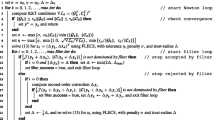Abstract
This chapter deals with iterative solution algorithms for the four EMI formulations derived in (17, Chapter 5). Order optimal monolithic solvers robust with respect to material parameters, the number of degrees of freedom of discretization as well as the time-stepping parameter are presented and compared in terms of computational cost. Domain decomposition solver for the single-dimensional primal formulation is discussed.
Chapter PDF
Similar content being viewed by others
References
Bærland T, Kuchta M, Mardal KA (2019) Multigrid methods for discrete fractional Sobolev spaces. SIAM Journal on Scientific Computing 41(2):A948–A972
Balay S, Abhyankar S, Adams MF, Brown J, Brune P, Buschelman K, Dalcin L, Dener A, Eijkhout V, Gropp WD, Karpeyev D, Kaushik D, Knepley MG, May DA, McInnes LC, Mills RT, Munson T, Rupp K, Sanan P, Smith BF, Zampini S, Zhang H, Zhang H (2019) PETSc Web page. https://www.mcs.anl.gov/petsc, URL https://www.mcs.anl.gov/petsc
Bonito A, Pasciak J (2015) Numerical approximation of fractional powers of elliptic operators. Mathematics of Computation 84(295):2083–2110
Braess D (2007) Finite Elements: Theory, Fast Solvers, and Applications in Solid Mechanics. Cambridge University Press, Cambridge
Bramble J, Pasciak J, Vassilevski P (2000) Computational scales of Sobolev norms with application to preconditioning. Mathematics of Computation 69(230):463–480
Brenner S, Scott R (2007) The mathematical theory of finite element methods, vol 15. Springer Science & Business Media
Brezzi F (1974) On the existence, uniqueness and approximation of saddle-point problems arising from Lagrangian multipliers. Revue française d’automatique, informatique, recherche opérationnelle Analyse numérique 8(2):129–151
Discacciati M, Quarteroni A, Valli A (2007) Robin–Robin domain decomposition methods for the Stokes–Darcy coupling. SIAM Journal on Numerical Analysis 45(3):1246–1268
Girault V, Raviart PA (2012) Finite Element Methods for Navier-Stokes Equations: Theory and Algorithms, vol 5. Springer Berlin Heidelberg, Berlin, Heidelberg
Hernandez V, Roman JE, Vidal V (2005) SLEPc: A scalable and flexible toolkit for the solution of eigenvalue problems. ACM Trans Math Software 31(3):351–362
Jæger KH, Tveito A (2020) Efficient numerical solution of the EMI model representing extracellular space (E), the cell membrane (M) and the intracellular space (I) of a collection of cardiac cells. Preprint
Jæger KH, Hustad KG, Cai X, Tveito A (2020) Operator splitting and finite difference schemes for solving the EMI model. In: Tveito A, Mardal KA, Rognes ME (eds) Modeling excitable tissue - The EMI framework, Simula Springer Notes in Computing, SpringerNature
Klawonn A, Widlund OB, Dryja M (2002) Dual-primal FETI methods for three-dimensional elliptic problems with heterogeneous coefficients. SIAM Journal on Numerical Analysis 40(1):159–179
Kolev TV, Vassilevski PS (2012) Parallel auxiliary space AMG solver for H(div) problems. SIAM Journal on Scientific Computing 34(6):A3079–A3098
Kuchta M, Mardal KA (2020) Software for EMI - Iterative solvers for EMI models. URL https://doi.org/10.5281/zenodo.3771212
Kuchta M, Nordaas M, Verschaeve JCG, Mortensen M, Mardal KA (2016) Preconditioners for saddle point systems with trace constraints coupling 2D and 1D domains. SIAM Journal on Scientific Computing 38(6):B962–B987
Kuchta M, Mardal KA, Rognes ME (2020) Solving the EMI equations using finite element methods. In: Tveito A, Mardal KA, Rognes ME (eds) Modeling excitable tissue - The EMI framework, Simula Springer Notes in Computing, SpringerNature
Mandel J, Dohrmann CR, Tezaur R (2005) An algebraic theory for primal and dual substructuring methods by constraints. Applied Nnumerical Mmathematics 54(2):167–193
Mardal KA,Winther R (2011) Preconditioning discretizations of systems of partial differential equations. Numerical Linear Algebra with Applications 18(1):1–40
Nielsen BF, Mardal KA (2013) Analysis of the minimal residual method applied to ill posed optimality systems. SIAM Journal on Scientific Computing 35(2):A785–A814
Smith B, Bjorstad P, Gropp W (2004) Domain Decomposition: Parallel Multilevel Methods for Elliptic Partial Differential Equations. Cambridge University Press, Cambridge
Tveito A, Jæger KH, Kuchta M, Mardal KA, Rognes ME (2017) A cell-based framework for numerical modeling of electrical conduction in cardiac tissue. Frontiers in Physics 5:48
Yang UM, et al. (2002) Boomeramg: a parallel algebraic multigrid solver and preconditioner. Applied Numerical Mathematics 41(1):155–177
Zampini S (2016) PCBDDC: a class of robust dual-primal methods in PETSc. SIAM Journal on Scientific Computing 38(5):S282–S306
Zampini S, Tu X (2017) Multilevel balancing domain decomposition by constraints deluxe algorithms with adaptive coarse spaces for flow in porous media. SIAM Journal on Scientific Computing 39(4):A1389–A1415
Author information
Authors and Affiliations
Corresponding author
Editor information
Editors and Affiliations
Rights and permissions
Open Access This chapter is licensed under the terms of the Creative Commons Attribution 4.0 International License (http://creativecommons.org/licenses/by/4.0/), which permits use, sharing, adaptation, distribution and reproduction in any medium or format, as long as you give appropriate credit to the original author(s) and the source, provide a link to the Creative Commons license and indicate if changes were made.
The images or other third party material in this chapter are included in the chapter's Creative Commons license, unless indicated otherwise in a credit line to the material. If material is not included in the chapter's Creative Commons license and your intended use is not permitted by statutory regulation or exceeds the permitted use, you will need to obtain permission directly from the copyright holder.
Copyright information
© 2021 The Author(s)
About this chapter
Cite this chapter
Kuchta, M., Mardal, KA. (2021). Iterative Solvers for EMI Models. In: Tveito, A., Mardal, KA., Rognes, M.E. (eds) Modeling Excitable Tissue. Simula SpringerBriefs on Computing(), vol 7. Springer, Cham. https://doi.org/10.1007/978-3-030-61157-6_6
Download citation
DOI: https://doi.org/10.1007/978-3-030-61157-6_6
Published:
Publisher Name: Springer, Cham
Print ISBN: 978-3-030-61156-9
Online ISBN: 978-3-030-61157-6
eBook Packages: Mathematics and StatisticsMathematics and Statistics (R0)




